Verdict
The Q Acoustics M40 is another fun and thoroughly engaging speaker system that plays nicely with a range of sources. This micro tower is easy to accommodate, less conspicuously hi-fi in its looks, and packs a rich, warm performance. However, it’s not the sharpest or most defined sound for those looking for the utmost fidelity.
Pros
- Rich, warm sense of sonic expression
- Discreet and smart looks
- Range of connectivity options
- Works as a second system or soundbar replacement
Cons
- Sense of dynamism is more minor than major
- No Wi-Fi support
- Not the sharpest or most defined performance
-
ConnectivityBluetooth support along with USB, optical digital and more -
BluetoothSupports up to 24-bit/48kHz aptX HD streaming -
C3 Continuous Curved ConeFor smoother integration between high and low frequencies
Introduction
While 3D audio formats such as Dolby Atmos continue to draw attention, don’t discount the re-emergence of two-channel audio, a (sonic) wave the Q Acoustics M40 looks to surf on.
Q Acoustics’ latest stereo system is a ‘micro tower’ which it hopes will create a new space within the speaker market.
It’s a speaker system that looks to fit in with the rest of your furniture, delivering big room-filling sound as either a soundbar replacement or a system for a second room.
Design
- Micro tower design
- Fixed baffled
- Cable to connect both speakers
The Q Acoustic M40 makes a tilt for the lifestyle market as the type of speaker that could cross the divide between hi-fi and casual users. That journey starts with its aesthetics, and at 710mm tall it’s less intimidating and conspicuous than a traditional floorstanding speaker would be.
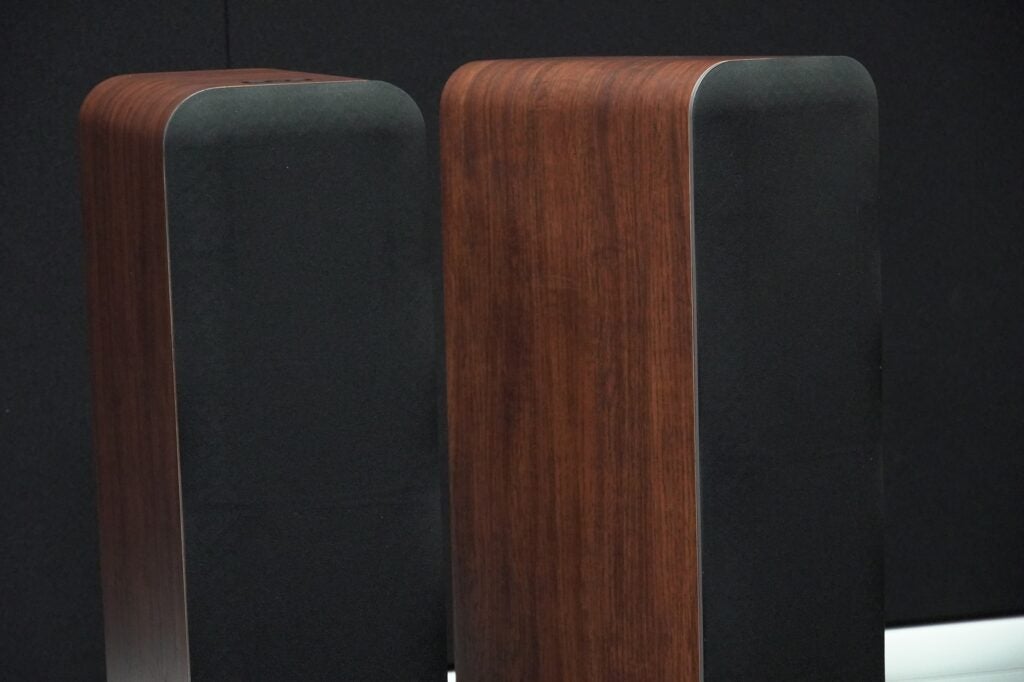
What may be a bugbear for some is the cable that attaches both speakers. The M40 isn’t fully wireless in the manner of the PSB Alpha IQ, though whether a connecting cable is a hardship is down to whether you like your space free of trailing cables. Hiding it behind a TV/rack stand ensures it’ll be out of sight and out of mind.
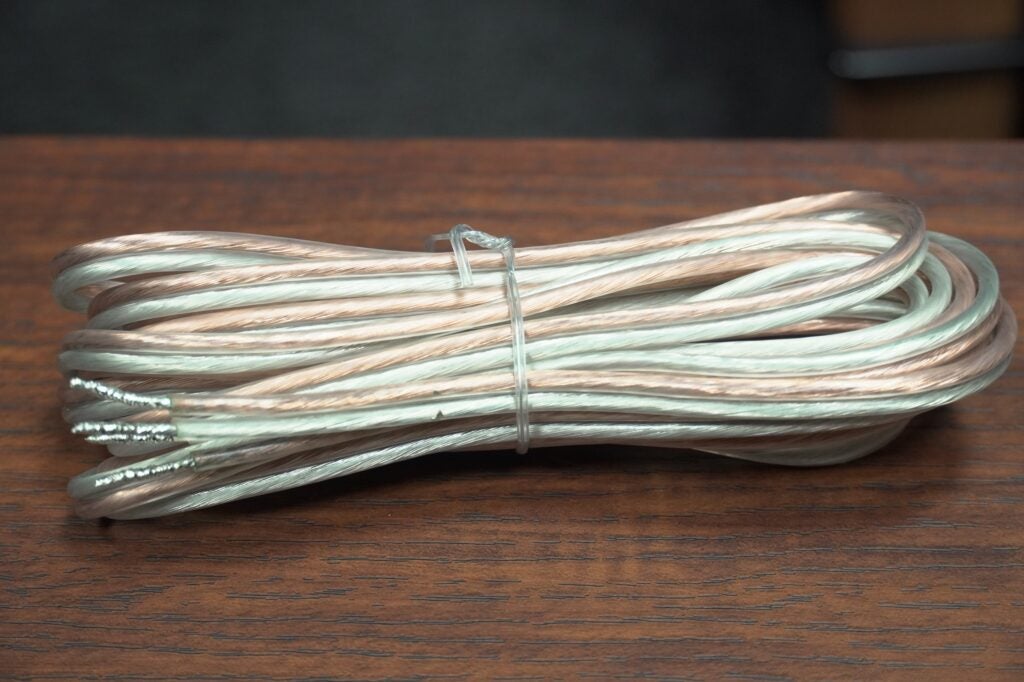
Provided in three finishes (black, white, and walnut), the M40 is a speaker that feels solid and hefty as well as looking smart. The front baffle can’t be detached – not a decision that bothers me, though some may prefer to have the option.
On the powered speaker are the connections and onboard controls for volume and input selection. Viewing the LED sitting down is a little tricky, though slightly easier than it was with the M20 HD.
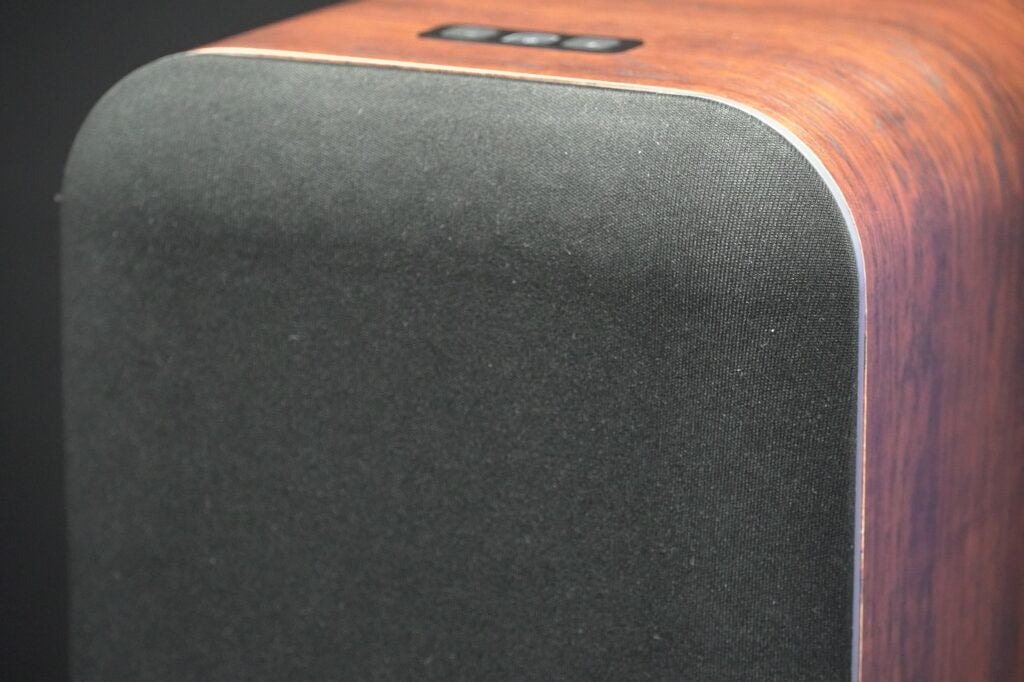
On the rear is a bass port for managing low frequencies. Place the M40 near a back wall and it’ll reinforce the bass – if you want to dampen it down there are foam bungs to fill it up.
There are rear stabilisers in the packaging, and so efficient is the packaging that they are hard to find at first. Spikes and covers are provided for the surface you’re placing the speakers on, and setup takes well over ten minutes, so perhaps bring a cup of tea for when you need a break.
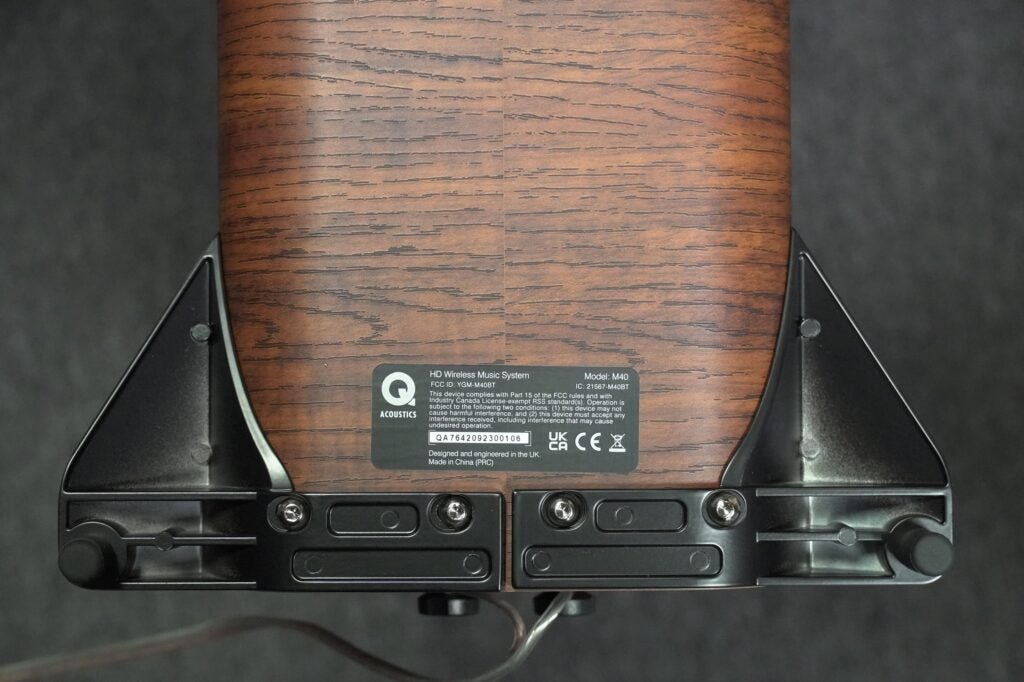
Features
- Range of connection options
- aptX HD Bluetooth
- Simple remote
Connections cover optical digital, USB (type B), 3.5mm analogue, and two phono inputs, along with a sub output. That allows for connection to a TV (or any device with an optical port), turntable, laptop, or the possibility of adding a subwoofer.
The USB-B connection is a little awkward, as it’s not as popular as type-A (at least to my knowledge). Q Acoustics doesn’t include a cable (or an optical cable for that matter), but if you have a printer, it likely has the cable you need. Or you can purchase one from QED.
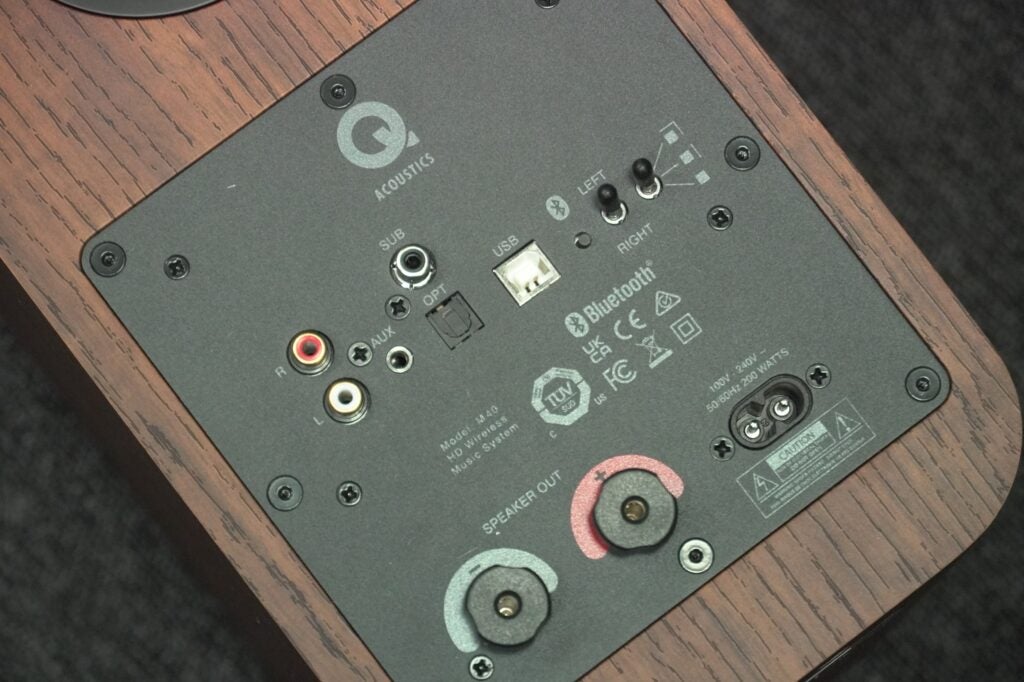
There’s no provision for HDMI ARC, but digital optical supports PCM, Dolby Digital and DTS stereo formats, and as this is a two-channel setup, it’s not a huge issue. But it would have been welcome to have it.
The remote is the same as the one that shipped with the M20, with buttons for volume, playback, muting, track skipping, and input selection. It’s a simple affair, though sometimes buttons need a jab to get a response, and it requires line of sight to operate.
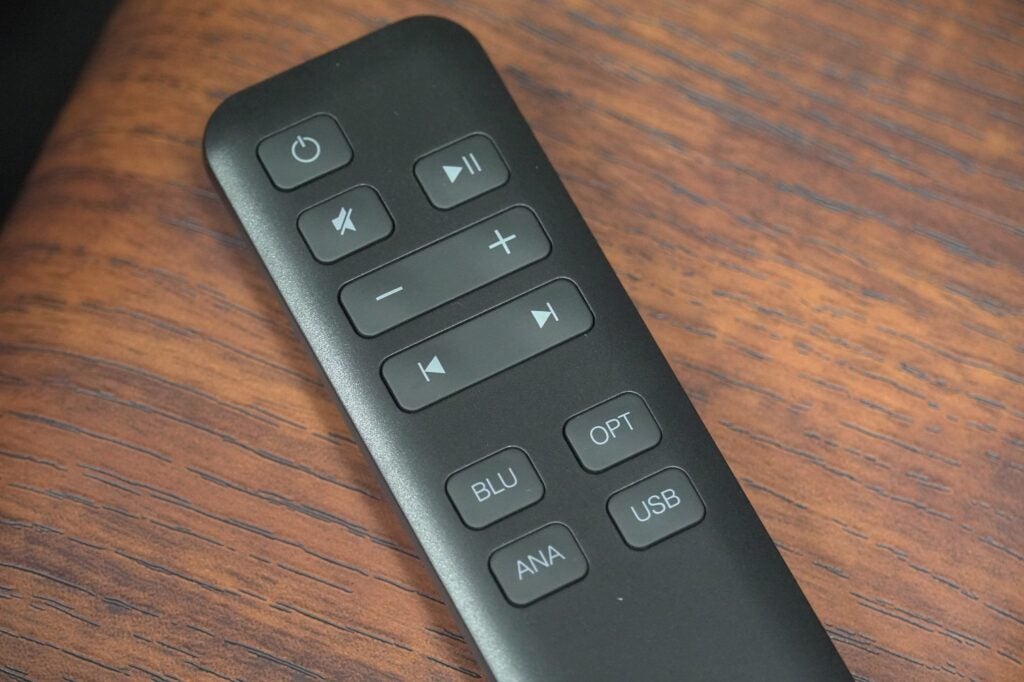
Having this remote means you’ll have to keep track of two controls if the M40 is connected to a TV. Pressing mute on the TV remote doesn’t exert control over the speakers, nor does turning on the TV automatically power the speakers.
More of an issue is figuring out the speakers’ volume level. Volume adjustments don’t register on a TV, and there’s no way of telling how quiet or loud the speaker is other than playing audio.
There’s no Wi-Fi compatibility, which skips another layer of convenience irrespective of whether the M40 is viewed as a soundbar replacement or a second room system. Wi-Fi feels more integral to hi-fi’s current direction than it did when the M20 HD launched in 2021.
Nevertheless, there’s Bluetooth 5 support with SBC, AAC, aptX, aptX Low Latency and aptX HD compatibility, though aptX HD is a lossy rather lossless audio format, which means data is lost over transmission despite aptX HD’s ability to support audio up to 24-bit/48kHz.
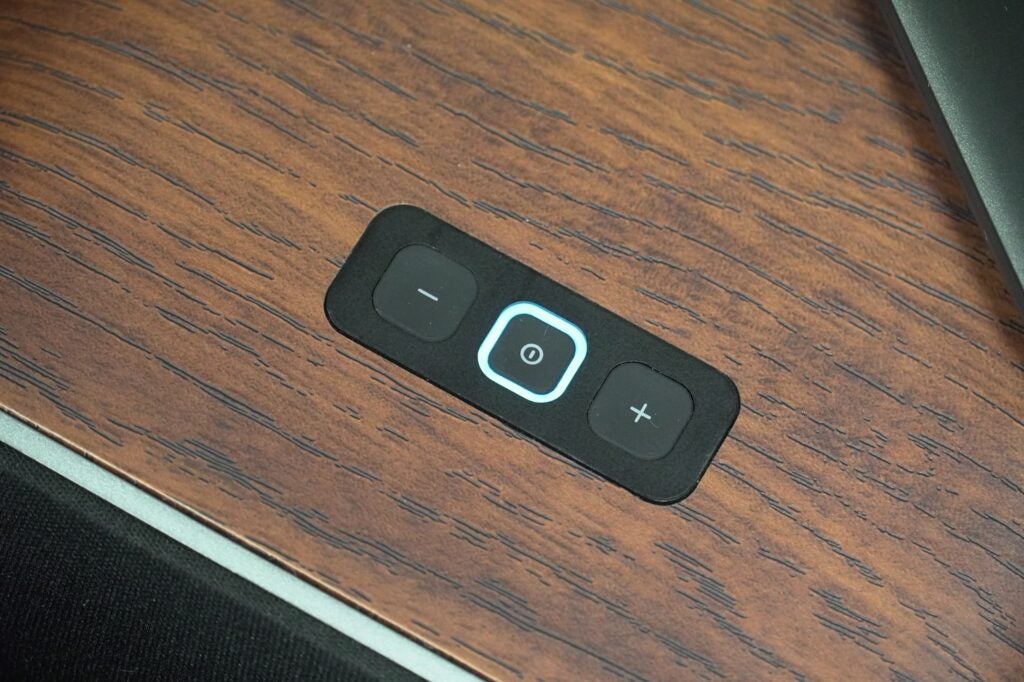
The USB input is your best bet for highest quality playback as it supports files up to 24-bit/192kHz (as does the optical input), and it’s not impacted by streaming issues or interference.
The EQ switch on the Q Active 200 model is back, allowing the user to switch between sound profiles depending on the system’s positioning (i.e. near a wall). Peak power is 2 x 100W (or 2 x 50W continuous into 4ohms); and the system can convey a wide frequency response of 38Hz – 22kHz.
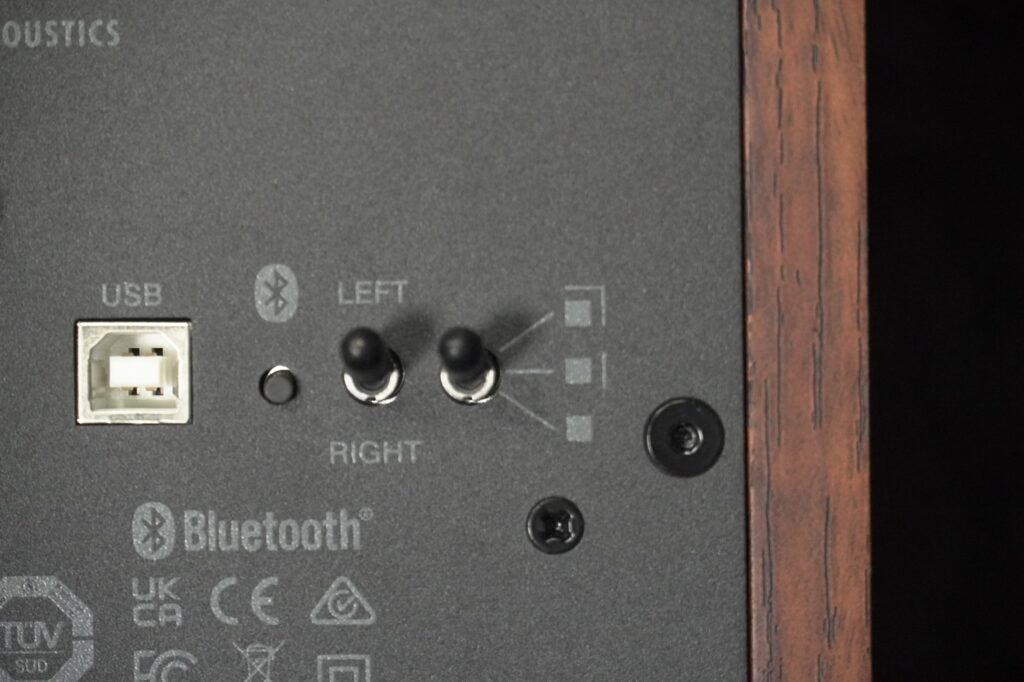
Sound Quality
- Rich, warm-sounding performance
- Lacks a degree of sharpness and definition
- Assertive but controlled bass output
Given the Q Acoustics M40’s flexibility, let’s start with its TV performance. It’s in-line with what Q Acoustics established with its M20 HD and 5000 series: a warm, smooth-sounding performance with a weighty, rich approach to describing bass.
It describes film and TV series with a wide, spacious soundstage that features depth with its stereo imaging. Its soundstage is also taller than I expected, though not Atmos in any form, as the spinner descends onto Sapper Morton’s farm in Blade Runner 2049 it tracks from above the TV before settling down in the middle of the screen. Who says you need Atmos for immersion?
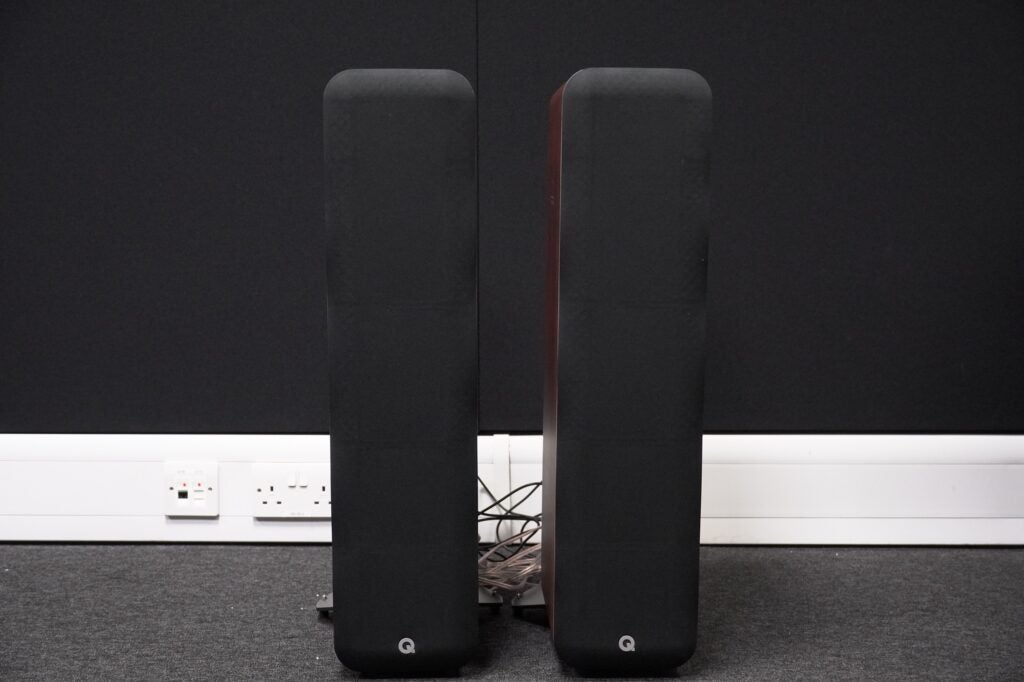
However, like with other “hi-fi” speakers I’ve tested that connect to a TV, I find sounds don’t always escape the cabinet. The cabinet is a hard stop, and no sounds pass beyond it to extend the width of the soundstage further. I can always tell when a sound comes from the cabinet itself because it sounds a little different.
The midrange is smoothly described, though the warmth impacts the M40’s levels of sharpness and definition. Despite that, voices are consistently clear, and the M40 captures the cadence and inflections of voices well, while placement of dialogue across the screen is well done.
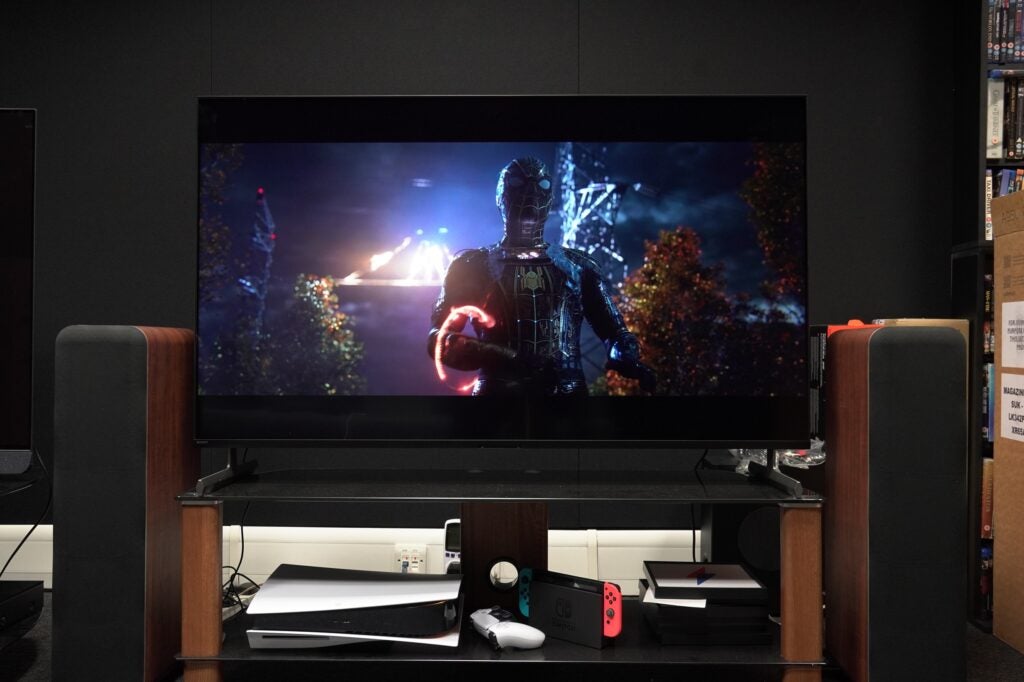
With male voices in a Netflix stream of Spider-Man: No Way Home there’s a slight bassy inflection to the likes of Dr Strange and Dr Octopus. But at least with both male and female voices, the Q Acoustics M40’s smoothness means it doesn’t fall into a sibilant trap.
John Wick: Chapter 4 and Blade Runner 2049 are good showcases for the energy, scale, and power the Q Acoustics M40 can gather. The bassy music score in the Osaka Continental scene from John Wick has punch and power, while there’s a nice meatiness to the volley of hits Donnie Zen’s Cane delivers in the action sequence.
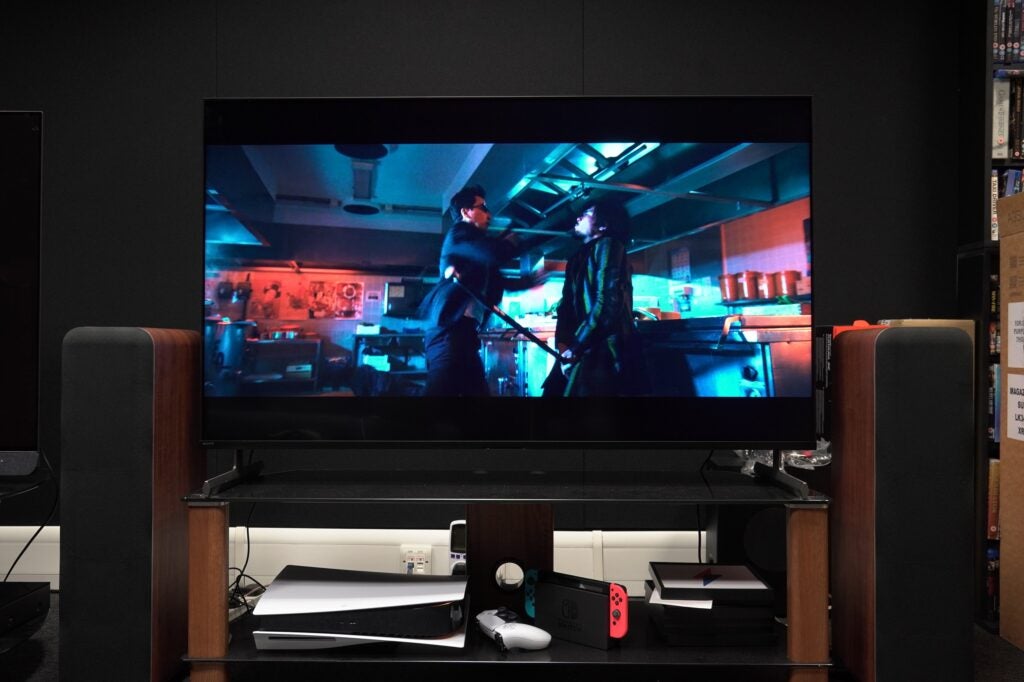
With 2049 the M40 sinks its teeth into the film’s dynamic range – at least at the lower end of the spectrum – with powerful, room-shaking bass that provides plenty of force to the punches administered by K to Sapper in their fight. The M40 isn’t leaden-footed with its bass performance either, diligently describing big, small, punchy or soft low frequency notes.
While there’s nice clarity and detail at the top end, I find the smoothness of the M40’s performance doesn’t elicit the crispest or sharpest sense of detail.
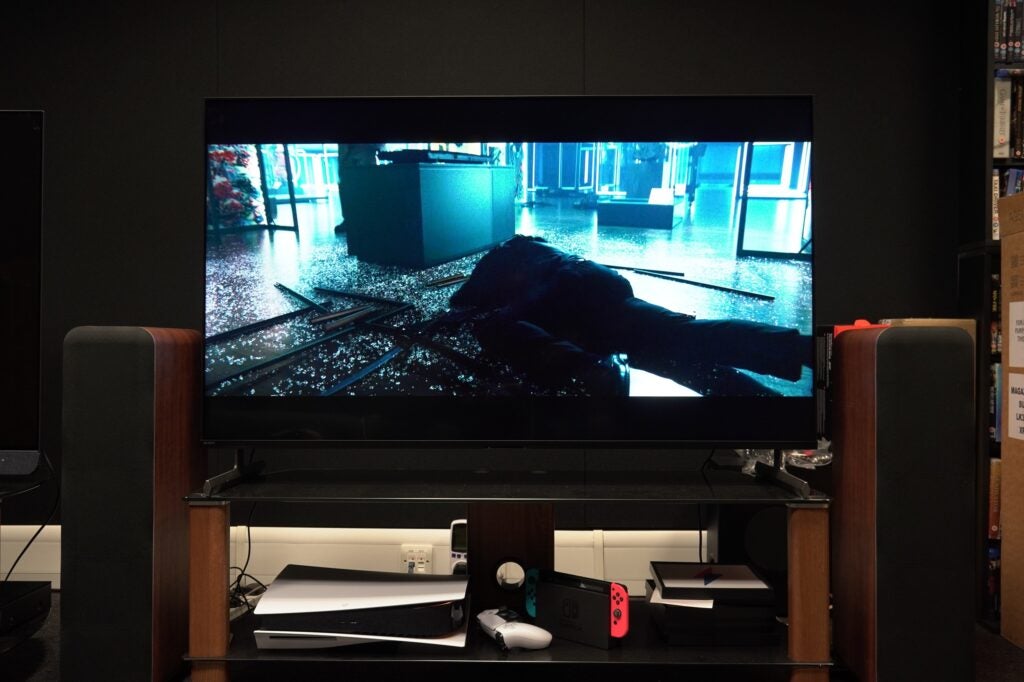
The sharp ringing sound in the ‘Interlinked’ scene from 2049 sounds dulled, while a fight set among Japanese artwork in John Wick. which sees both the title character and High Table soldiers sent careering through glass walls, lacks crispness. Gunshots register smoothly, lacking the snappiness and attack that would give the mids and highs more punch and bite.
Dynamically, the M40 is rather broad, getting slightly louder or quieter; though panning across the soundstage is strong in a series such as Netflix’s Drive to Survive. In the end, the M40’s performance is leagues better than a TV’s built-in speakers.
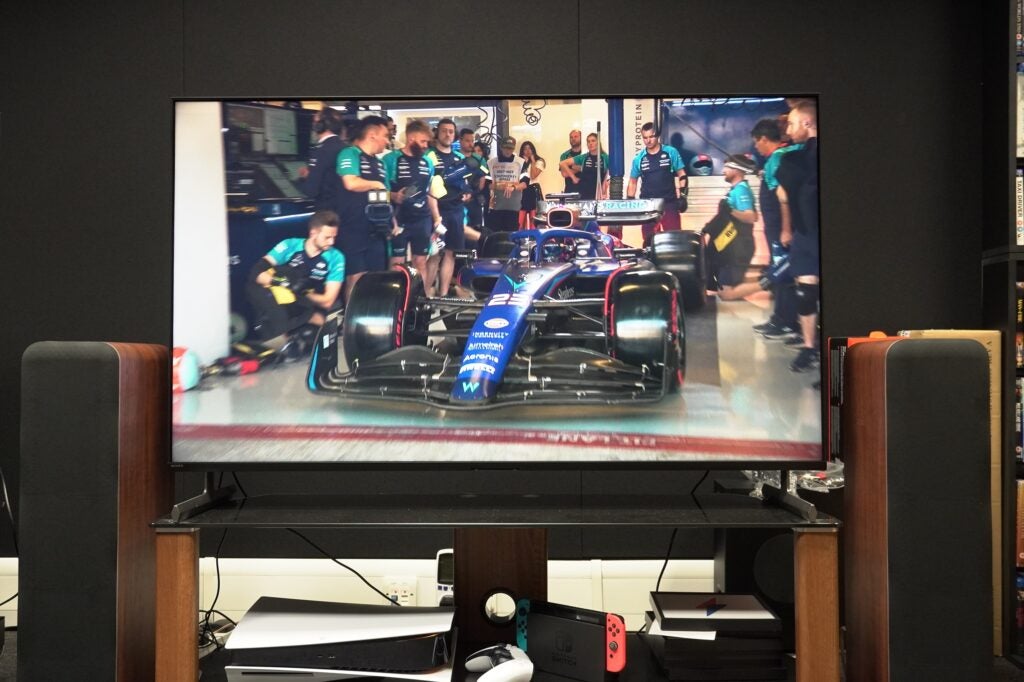
With music there are a few potential ways of getting audio to the speaker: Bluetooth, the USB input, or streaming to a connected TV and sending it down the 24-bit/192kHz optical connection.
So I start with a Qobuz 24-bit/44.1kHz stream (Chromecast) of Better Oblivion Community Centre’s Didn’t Know What I Was In For delivered via a Sony X85L. Sound quality is crisp, with good levels of midrange detail, and robust bass that offers punch to low frequencies.
It’s a reminder the M40’s default delivery is a spacious, powerful sound that fills a room. With Sleepwalkin’ there’s good slam to the bass that opens the track, further emboldened by meaty hits of the percussion. Moving to boygenius’ $20, and playback is infectiously energetic, though it’s worth noting that through the TV, the M40 can sound a little too sharp.
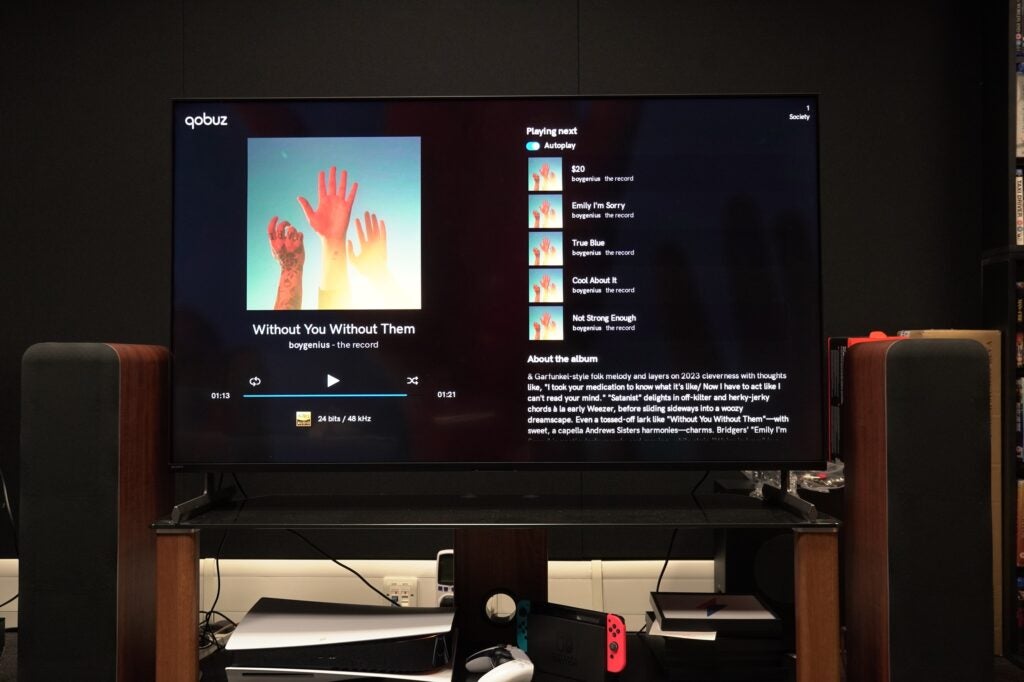
Switching to a Bluetooth connection and playback is smoother, clearer in some ways with less sharpness evident. Bass isn’t as weighty or punchy, but the result is a more balanced listening experience. I find the M40 an engaging, frequently fun-sounding audio system.
With GoGo Penguin’s Atomised, the treble is nicely bright, even though it sounds somewhat rolled off. With Andreas Ihlebæk’s Come Summer, the M40’s Bluetooth performance is again bright, though lacking a degree of definition. Playing the same track through the TV via Wi-Fi (Tidal Connect) and I pick up more detail and clarity.
Plugging a laptop into the USB input and the M40’s tone doesn’t alter. Listening to a FLAC file of Phoebe Bridgers’ Punisher, the Q Acoustics M40 commits to its warm-sound, boasting good clarity to Bridgers’ voice and rich bass. I’ll repeat that it’s not the sharpest or the most defined listen but if you’re still reading that likely doesn’t bother you.
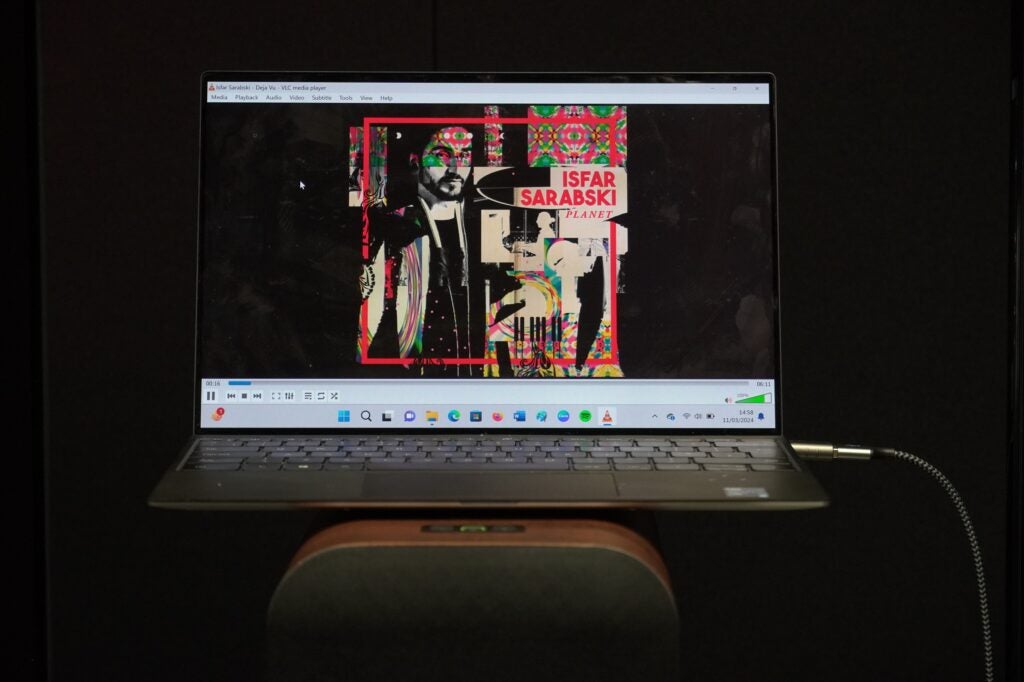
Switching to the WMA file of Isfar Sarabski’s Planet and while brightness registers at the top end it’s aligned with the speaker’s natural warmth that results in a slightly rolled-off sound. Regardless, there’s a lovely rich clarity and variation to its high frequency performance that I find engaging.
The percussion and hi-hat cymbals in Limping Stranger lack the crispness I’m looking for, but the next track in Swan Lake provides another reminder of the M40’s qualities with an assertive bass performance. The Q Acoustics M40, like the M20 HD before it, is never less than a thoroughly entertaining speaker system when in full flow.
Latest deals
Should you buy it?
If you enjoy the simplicity of two-channel sound
Not interested in immersive audio? Then perhaps a speaker such as the M40 is for you, especially as it can operate both as a separate system or one that connects to a TV.
You want more convenience
The lack of Wi-Fi and HDMI ARC are flies in the ointment in terms of convenience. The lack of the former is particularly notable, with Q Acoustics seemingly courting more of a casual/lifestyle audience with this speaker.
Final Thoughts
The Q Acoustics M40 is another powerful and engaging speaker system, but its warm-sounding profile means it’s not the sharpest or most defined performance. If that doesn’t bother you, I think you’ll greatly appreciate the performance here.
The flexibility of the speaker system is another aspect to consider as you can hook it up to a TV or a turntable, plug a source in through USB or stream via Bluetooth. Wi-Fi compatibility would have been nice for convenience sake though.
This micro tower can do plenty, maybe not all I’d want in the way I’d want, but in terms of opening up a new space within the market, I think Q Acoustics is onto a winner with the M40.
How we test
We test every speaker system we review thoroughly over an extended period of time. We use industry standard tests to compare features properly. We’ll always tell you what we find. We never, ever, accept money to review a product.
Find out more about how we test in our ethics policy.
Tested with real world use
Bluetooth, TV, and USB audio sources tested
FAQs
There aren’t any cable accessories included with the M40, so if you’re going to use either the USB or optical digital cables, you’ll need to purchase them.
Verdict
The Q Acoustics M40 is another fun and thoroughly engaging speaker system that plays nicely with a range of sources. This micro tower is easy to accommodate, less conspicuously hi-fi in its looks, and packs a rich, warm performance. However, it’s not the sharpest or most defined sound for those looking for the utmost fidelity.
Pros
- Rich, warm sense of sonic expression
- Discreet and smart looks
- Range of connectivity options
- Works as a second system or soundbar replacement
Cons
- Sense of dynamism is more minor than major
- No Wi-Fi support
- Not the sharpest or most defined performance
-
ConnectivityBluetooth support along with USB, optical digital and more -
BluetoothSupports up to 24-bit/48kHz aptX HD streaming -
C3 Continuous Curved ConeFor smoother integration between high and low frequencies
Introduction
While 3D audio formats such as Dolby Atmos continue to draw attention, don’t discount the re-emergence of two-channel audio, a (sonic) wave the Q Acoustics M40 looks to surf on.
Q Acoustics’ latest stereo system is a ‘micro tower’ which it hopes will create a new space within the speaker market.
It’s a speaker system that looks to fit in with the rest of your furniture, delivering big room-filling sound as either a soundbar replacement or a system for a second room.
Design
- Micro tower design
- Fixed baffled
- Cable to connect both speakers
The Q Acoustic M40 makes a tilt for the lifestyle market as the type of speaker that could cross the divide between hi-fi and casual users. That journey starts with its aesthetics, and at 710mm tall it’s less intimidating and conspicuous than a traditional floorstanding speaker would be.

What may be a bugbear for some is the cable that attaches both speakers. The M40 isn’t fully wireless in the manner of the PSB Alpha IQ, though whether a connecting cable is a hardship is down to whether you like your space free of trailing cables. Hiding it behind a TV/rack stand ensures it’ll be out of sight and out of mind.

Provided in three finishes (black, white, and walnut), the M40 is a speaker that feels solid and hefty as well as looking smart. The front baffle can’t be detached – not a decision that bothers me, though some may prefer to have the option.
On the powered speaker are the connections and onboard controls for volume and input selection. Viewing the LED sitting down is a little tricky, though slightly easier than it was with the M20 HD.

On the rear is a bass port for managing low frequencies. Place the M40 near a back wall and it’ll reinforce the bass – if you want to dampen it down there are foam bungs to fill it up.
There are rear stabilisers in the packaging, and so efficient is the packaging that they are hard to find at first. Spikes and covers are provided for the surface you’re placing the speakers on, and setup takes well over ten minutes, so perhaps bring a cup of tea for when you need a break.

Features
- Range of connection options
- aptX HD Bluetooth
- Simple remote
Connections cover optical digital, USB (type B), 3.5mm analogue, and two phono inputs, along with a sub output. That allows for connection to a TV (or any device with an optical port), turntable, laptop, or the possibility of adding a subwoofer.
The USB-B connection is a little awkward, as it’s not as popular as type-A (at least to my knowledge). Q Acoustics doesn’t include a cable (or an optical cable for that matter), but if you have a printer, it likely has the cable you need. Or you can purchase one from QED.

There’s no provision for HDMI ARC, but digital optical supports PCM, Dolby Digital and DTS stereo formats, and as this is a two-channel setup, it’s not a huge issue. But it would have been welcome to have it.
The remote is the same as the one that shipped with the M20, with buttons for volume, playback, muting, track skipping, and input selection. It’s a simple affair, though sometimes buttons need a jab to get a response, and it requires line of sight to operate.

Having this remote means you’ll have to keep track of two controls if the M40 is connected to a TV. Pressing mute on the TV remote doesn’t exert control over the speakers, nor does turning on the TV automatically power the speakers.
More of an issue is figuring out the speakers’ volume level. Volume adjustments don’t register on a TV, and there’s no way of telling how quiet or loud the speaker is other than playing audio.
There’s no Wi-Fi compatibility, which skips another layer of convenience irrespective of whether the M40 is viewed as a soundbar replacement or a second room system. Wi-Fi feels more integral to hi-fi’s current direction than it did when the M20 HD launched in 2021.
Nevertheless, there’s Bluetooth 5 support with SBC, AAC, aptX, aptX Low Latency and aptX HD compatibility, though aptX HD is a lossy rather lossless audio format, which means data is lost over transmission despite aptX HD’s ability to support audio up to 24-bit/48kHz.

The USB input is your best bet for highest quality playback as it supports files up to 24-bit/192kHz (as does the optical input), and it’s not impacted by streaming issues or interference.
The EQ switch on the Q Active 200 model is back, allowing the user to switch between sound profiles depending on the system’s positioning (i.e. near a wall). Peak power is 2 x 100W (or 2 x 50W continuous into 4ohms); and the system can convey a wide frequency response of 38Hz – 22kHz.

Sound Quality
- Rich, warm-sounding performance
- Lacks a degree of sharpness and definition
- Assertive but controlled bass output
Given the Q Acoustics M40’s flexibility, let’s start with its TV performance. It’s in-line with what Q Acoustics established with its M20 HD and 5000 series: a warm, smooth-sounding performance with a weighty, rich approach to describing bass.
It describes film and TV series with a wide, spacious soundstage that features depth with its stereo imaging. Its soundstage is also taller than I expected, though not Atmos in any form, as the spinner descends onto Sapper Morton’s farm in Blade Runner 2049 it tracks from above the TV before settling down in the middle of the screen. Who says you need Atmos for immersion?

However, like with other “hi-fi” speakers I’ve tested that connect to a TV, I find sounds don’t always escape the cabinet. The cabinet is a hard stop, and no sounds pass beyond it to extend the width of the soundstage further. I can always tell when a sound comes from the cabinet itself because it sounds a little different.
The midrange is smoothly described, though the warmth impacts the M40’s levels of sharpness and definition. Despite that, voices are consistently clear, and the M40 captures the cadence and inflections of voices well, while placement of dialogue across the screen is well done.

With male voices in a Netflix stream of Spider-Man: No Way Home there’s a slight bassy inflection to the likes of Dr Strange and Dr Octopus. But at least with both male and female voices, the Q Acoustics M40’s smoothness means it doesn’t fall into a sibilant trap.
John Wick: Chapter 4 and Blade Runner 2049 are good showcases for the energy, scale, and power the Q Acoustics M40 can gather. The bassy music score in the Osaka Continental scene from John Wick has punch and power, while there’s a nice meatiness to the volley of hits Donnie Zen’s Cane delivers in the action sequence.

With 2049 the M40 sinks its teeth into the film’s dynamic range – at least at the lower end of the spectrum – with powerful, room-shaking bass that provides plenty of force to the punches administered by K to Sapper in their fight. The M40 isn’t leaden-footed with its bass performance either, diligently describing big, small, punchy or soft low frequency notes.
While there’s nice clarity and detail at the top end, I find the smoothness of the M40’s performance doesn’t elicit the crispest or sharpest sense of detail.

The sharp ringing sound in the ‘Interlinked’ scene from 2049 sounds dulled, while a fight set among Japanese artwork in John Wick. which sees both the title character and High Table soldiers sent careering through glass walls, lacks crispness. Gunshots register smoothly, lacking the snappiness and attack that would give the mids and highs more punch and bite.
Dynamically, the M40 is rather broad, getting slightly louder or quieter; though panning across the soundstage is strong in a series such as Netflix’s Drive to Survive. In the end, the M40’s performance is leagues better than a TV’s built-in speakers.

With music there are a few potential ways of getting audio to the speaker: Bluetooth, the USB input, or streaming to a connected TV and sending it down the 24-bit/192kHz optical connection.
So I start with a Qobuz 24-bit/44.1kHz stream (Chromecast) of Better Oblivion Community Centre’s Didn’t Know What I Was In For delivered via a Sony X85L. Sound quality is crisp, with good levels of midrange detail, and robust bass that offers punch to low frequencies.
It’s a reminder the M40’s default delivery is a spacious, powerful sound that fills a room. With Sleepwalkin’ there’s good slam to the bass that opens the track, further emboldened by meaty hits of the percussion. Moving to boygenius’ $20, and playback is infectiously energetic, though it’s worth noting that through the TV, the M40 can sound a little too sharp.

Switching to a Bluetooth connection and playback is smoother, clearer in some ways with less sharpness evident. Bass isn’t as weighty or punchy, but the result is a more balanced listening experience. I find the M40 an engaging, frequently fun-sounding audio system.
With GoGo Penguin’s Atomised, the treble is nicely bright, even though it sounds somewhat rolled off. With Andreas Ihlebæk’s Come Summer, the M40’s Bluetooth performance is again bright, though lacking a degree of definition. Playing the same track through the TV via Wi-Fi (Tidal Connect) and I pick up more detail and clarity.
Plugging a laptop into the USB input and the M40’s tone doesn’t alter. Listening to a FLAC file of Phoebe Bridgers’ Punisher, the Q Acoustics M40 commits to its warm-sound, boasting good clarity to Bridgers’ voice and rich bass. I’ll repeat that it’s not the sharpest or the most defined listen but if you’re still reading that likely doesn’t bother you.

Switching to the WMA file of Isfar Sarabski’s Planet and while brightness registers at the top end it’s aligned with the speaker’s natural warmth that results in a slightly rolled-off sound. Regardless, there’s a lovely rich clarity and variation to its high frequency performance that I find engaging.
The percussion and hi-hat cymbals in Limping Stranger lack the crispness I’m looking for, but the next track in Swan Lake provides another reminder of the M40’s qualities with an assertive bass performance. The Q Acoustics M40, like the M20 HD before it, is never less than a thoroughly entertaining speaker system when in full flow.
Latest deals
Should you buy it?
If you enjoy the simplicity of two-channel sound
Not interested in immersive audio? Then perhaps a speaker such as the M40 is for you, especially as it can operate both as a separate system or one that connects to a TV.
You want more convenience
The lack of Wi-Fi and HDMI ARC are flies in the ointment in terms of convenience. The lack of the former is particularly notable, with Q Acoustics seemingly courting more of a casual/lifestyle audience with this speaker.
Final Thoughts
The Q Acoustics M40 is another powerful and engaging speaker system, but its warm-sounding profile means it’s not the sharpest or most defined performance. If that doesn’t bother you, I think you’ll greatly appreciate the performance here.
The flexibility of the speaker system is another aspect to consider as you can hook it up to a TV or a turntable, plug a source in through USB or stream via Bluetooth. Wi-Fi compatibility would have been nice for convenience sake though.
This micro tower can do plenty, maybe not all I’d want in the way I’d want, but in terms of opening up a new space within the market, I think Q Acoustics is onto a winner with the M40.
How we test
We test every speaker system we review thoroughly over an extended period of time. We use industry standard tests to compare features properly. We’ll always tell you what we find. We never, ever, accept money to review a product.
Find out more about how we test in our ethics policy.
Tested with real world use
Bluetooth, TV, and USB audio sources tested
FAQs
There aren’t any cable accessories included with the M40, so if you’re going to use either the USB or optical digital cables, you’ll need to purchase them.
























